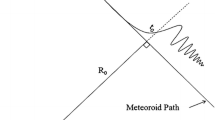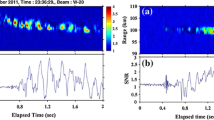Abstract
The pulse-integrated signal to noise ratio as a function of time known as radar meteor light curve (analogous to optical light curve), is an indicative of ablation processes during meteoroid flight in the atmosphere. In this study, we present and discuss few examples of light curves of long duration specular overdense meteor echoes detected with 53 MHz Gadanki (\(13.5^{\circ}N\), \(79.2^{\circ}E\)) MST radar. These echoes are of several seconds duration, where pulsation in amplitude is about ten cycles within few seconds. This means the fluctuations in amplitude are much slower than typical Fresnel oscillations of underdense as well as the head echo fluctuations. These light curves reveal several features unreported previously in the radar meteor returns that are consistent with meteoroid fragmentation. Some of them provide the strong observational evidence of a sub-millimeter-sized meteoroid, breaking apart into two distinct fragments. The pulsations in light curves are interpreted as being due to interference from two distinct scattering centers. Some other meteor events such as meteoroids undergoing quasi-continuous disintegration are also discussed.





Similar content being viewed by others
References
Badger, D.P.: Fine structure in radio meteor showers. Ph.D. Thesis, University of Adelaide (2002)
Baggaley, W.J.: Radar observations. In: Murad, E., Williams, I.P. (eds.) Meteors in the Earth’s Atmosphere, p. 123. Cambridge University Press, Cambridge (2002)
Bronshten, V.A.: Physics of Meteor Flight in the Atmosphere. Reidel, Dordrecht (1983)
Campbell, M.D., Brown, P.G., Leblanc, A.G., Hawkes, R.L., Jones, J., Worden, S.P., Correll, R.R.: Image-intensified video results from the 1998 Leonid shower: I. Atmospheric trajectories and physical structure. Meteorit. Planet. Sci. 35(6), 1259–1267 (2000)
Campbell-Brown, M.D., Close, S.: Meteoroid structure from radar head echoes. Mon. Not. R. Astron. Soc. 382(3), 1309–1316 (2007)
Campbell-Brown, M.D., Koschny, D.: Model of the ablation of faint meteors. Astron. Astrophys. 418, 751–758 (2004)
Ceplecha, Z., Borovicka, J., Elford, W.G., Revelle, R.O., Hawkes, R.L., Porubcan, V., Simek, M.: Meteor phenomena and bodies. Space Sci. Rev. 84(3/4), 327–471 (1998)
Chapin, E., Kudeki, E.: Radar interferometric imaging studies of long-duration meteor echoes observed at Jicamarca. J. Geophys. Res. 99(A5), 8937–8949 (1994)
Close, S., Oppenheim, M.M., Hunt, S., Dyrud, L.: Scattering characteristics of high-resolution meteor head echoes detected at multiple frequencies. J. Geophys. Res. Space Phys. 107(A10), SIA 9-1 (2002). CiteID 1295. doi:10.1029/2002JA009253
Dimant, Y.S., Oppenheim, M.M.: Meteor trail diffusion and fields: 1. Simulations. J. Geophys. Res. Space Phys. 111(A12) (2006). CiteID A12312
Dyrud, L.P., Kudeki, E., Oppenheim, M.M.: Modeling long duration meteor trails. J. Geophys. Res. 112(A12) (2007). CiteID A12307
Dyrud, L.P., Oppenheim, M.M., Close, S., Hunt, S.: Interpretation of non-specular radar meteor trails. J. Geophys. Res. 29(21), 8-1–8-4 (2012). CiteID 2012. doi:10.1029/2002GL015953
Elford, W.G.: Novel applications of MST radars in meteor studies. J. Atmos. Sol.-Terr. Phys. 63(2/3), 143–153 (2001)
Elford, W.G.: Radar observations of meteor trails, and their interpretation using Fresnel holography: a new tool in meteor science. Atmos. Chem. Phys. 4, 911–921 (2004)
Evans, J.V.: Radio-echo studies of meteors at 68-centimeter wavelength. J. Geophys. Res. 70(21), 5395–5416 (1965)
Fisher, A., Hawkes, R.L., Murray, I.S., Campbell, M.D., Leblanc, A.G.: Are meteoroids really dustballs? Planet. Space Sci. 48(10), 911–920 (2000)
Hawkes, R.L., Jones, J.: A quantitative model for the ablation of dustball meteors. Mon. Not. R. Astron. Soc. 173, 339–356 (1975)
Jacchia, L.G.: The physical theory of meteors—VIII: fragmentation as cause of the faintmeteor anomaly. Astrophys. J. 121, 521 (1955)
Janches, D., Close, S., Fentzke, J.T.: A comparison of detection sensitivity between ALTAIR and arecibo meteor observations: can high power and large aperture radars detect low velocity meteor head-echoes. Icarus 193(1), 105–111 (2008)
Janches, D., Nolan, M.C., Meisel, D.D., Mathews, J.D., Zhou, Q.H., Moser, D.E.: On the geocentric micrometeor velocity distribution. J. Geophys. Res. Space Phys. 108(A6), SIA 1-1 (2003). doi:10.1029/2002JA009789
Kelley, M.C.: A new explanation for long-duration meteor radar echoes: Persistent charged dust trains. Radio Sci. 39(2) (2004)
Kelley, M.C., Alcala, C., Cho, J.Y.N.: Detection of a meteor contrail and meteoric dust in the Earth’s upper mesosphere. J. Atmos. Sol.-Terr. Phys. 60(3), 359–369 (1998)
Kero, J., Szasz, C., Pellinen-Wannberg, A., Wannberg, G., Westman, A., Meisel, D.D.: Three-dimensional radar observation of a submillimeter meteoroid fragmentation. Geophys. Res. Lett. 35, L04101 (2008)
McKinley, D.W.R.: Meteor Science and Engineering. McGraw-Hill, New York (1961)
Murray, I.S., Hawkes, R.L., Jenniskens, P.: Airborne intensified charge-coupled device observations of the 1998 Leonid shower. Meteorit. Planet. Sci. 34(6), 949–958 (1999)
Oppenheim, M.M., Sugar, G., Bass, E., Dimant, Y.S., Chau, J.: Day to night variation in meteor trail measurements: Evidence for a new theory of plasma trail evolution. Geophys. Res. Lett. 35(3) (2008). CiteID L03102
Patil, A., Malhotra, A., Patra, K., Prasad, T.R., Mathews, J.D.: Evidence of meteoroid fragmentation in specular trail echoes observed using gadanki MST radar. Earth Moon Planets 114(3–4), 89–99 (2015)
Rao, P.B., Jain, A.R., Kishore, P., Balamuralidhar, P., Damle, S.H., Viswanathan, G.: Indian MST radar. 1. System description and sample vector wind measurements in ST mode. Radio Sci. 30, 1125–1138 (1995)
Reddy, K.C., Yellaiah, G.: The 2011 draconids meteor light curves and meteoroid fragmentation. Earth Moon Planets 114, 159–169 (2015)
Stokan, E., Campbell-Brown, M.D.: Transverse motion of fragmenting faint meteors observed with the Canadian automated meteor observatory. Icarus 232, 1–12 (2014)
Whipple, F.L.: A comet model. I. The acceleration of comet Encke. Astrophys. J. 111, 375–394 (1950)
Zhao, S., Urbina, U., Dyrud, L., Seal, R.: Multilayer detection and classification of specular and nonspecular meteor trails. Radio Sci. 46, RS6009 (2011). doi:10.1029/2010RS004548
Zhou, Q.H., Mathews, J.D., Nakamura, T.: Implications of meteor observations by the MU Radar. Geophys. Res. Lett. 28(7), 1399–1402 (2001)
Zhou, Q.H., Perillat, P., Cho, J.Y.N., Mathews, J.D.: Simultaneous meteor echo observations by large-aperture VHF and UHF radars. Radio Sci. 33(6), 1641–1654 (1998)
Acknowledgements
The authors thankful to the Director and Staff of NARL, Gadanki for their support in conducting experiment. The authors acknowledge DST-SERB, India for financial assistant through research project. One of the authors, KCR thankful to the UGC, India for UGC-BSR Research Start-Up Grant. The kind help of W.G. Elford in developing the manuscript is appreciated.
Author information
Authors and Affiliations
Corresponding author
Rights and permissions
About this article
Cite this article
Chenna Reddy, K., Yellaiah, G. Fragmentation of specular overdense meteor trail echoes observed with Gadanki MST radar. Astrophys Space Sci 361, 83 (2016). https://doi.org/10.1007/s10509-016-2670-y
Received:
Accepted:
Published:
DOI: https://doi.org/10.1007/s10509-016-2670-y




